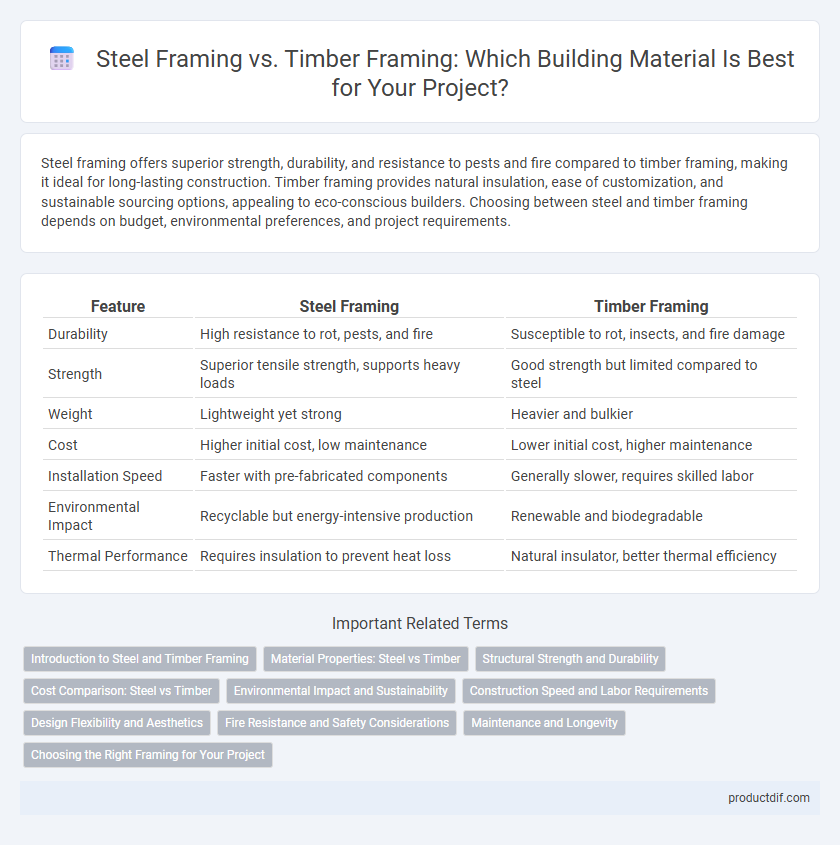Steel framing offers superior strength, durability, and resistance to pests and fire compared to timber framing, making it ideal for long-lasting construction. Timber framing provides natural insulation, ease of customization, and sustainable sourcing options, appealing to eco-conscious builders. Choosing between steel and timber framing depends on budget, environmental preferences, and project requirements.
Table of Comparison
| Feature | Steel Framing | Timber Framing |
|---|---|---|
| Durability | High resistance to rot, pests, and fire | Susceptible to rot, insects, and fire damage |
| Strength | Superior tensile strength, supports heavy loads | Good strength but limited compared to steel |
| Weight | Lightweight yet strong | Heavier and bulkier |
| Cost | Higher initial cost, low maintenance | Lower initial cost, higher maintenance |
| Installation Speed | Faster with pre-fabricated components | Generally slower, requires skilled labor |
| Environmental Impact | Recyclable but energy-intensive production | Renewable and biodegradable |
| Thermal Performance | Requires insulation to prevent heat loss | Natural insulator, better thermal efficiency |
Introduction to Steel and Timber Framing
Steel framing offers superior strength, durability, and resistance to pests and fire compared to timber framing, making it ideal for commercial and high-rise construction. Timber framing provides natural insulation, sustainability, and flexibility in design, favoring residential and low-rise buildings. Both materials require specific expertise for installation and impact the overall cost, maintenance, and environmental footprint of a structure.
Material Properties: Steel vs Timber
Steel framing offers superior strength-to-weight ratio, corrosion resistance, and uniformity compared to timber, making it ideal for high-load and long-span structures. Timber framing provides natural insulation, sustainability, and ease of modification, with better thermal performance but lower resistance to pests and fire. Steel's non-combustible nature and dimensional stability contrast with timber's susceptibility to moisture and shrinkage under varying environmental conditions.
Structural Strength and Durability
Steel framing offers superior structural strength with high tensile capacity and resistance to warping, twisting, and pests, ensuring long-term durability in various environmental conditions. Timber framing provides natural flexibility and insulation benefits but is more susceptible to moisture damage, termites, and fire hazards, which can compromise its longevity. Choosing steel framing enhances the resilience and lifespan of construction projects, especially in areas prone to extreme weather or seismic activity.
Cost Comparison: Steel vs Timber
Steel framing typically incurs higher upfront costs compared to timber due to the price of raw materials and specialized labor requirements. Timber framing offers cost advantages through lower material prices and faster construction times, reducing overall labor expenses. Long-term maintenance and durability factors can affect total lifecycle costs, with steel often providing greater resistance to pests and fire, potentially lowering future repair costs.
Environmental Impact and Sustainability
Steel framing offers higher recyclability and durability, significantly reducing waste and resource consumption over time compared to timber framing. Timber framing, when sourced responsibly from certified forests, provides a renewable and carbon-sequestering building material that supports carbon neutrality goals. Life cycle assessments show that steel's energy-intensive production contrasts with timber's ability to store carbon, making sustainability outcomes highly dependent on sourcing and usage patterns.
Construction Speed and Labor Requirements
Steel framing significantly reduces construction time compared to timber framing due to pre-fabricated components and faster assembly on-site. Labor requirements for steel framing involve specialized skills in welding and metalwork, while timber framing relies more on traditional carpentry with a broader labor pool. The precision and durability of steel framing contribute to streamlined project timelines and potentially lower overall labor costs.
Design Flexibility and Aesthetics
Steel framing offers superior design flexibility due to its high strength-to-weight ratio, enabling longer spans and more open floor plans without the need for load-bearing walls. Timber framing provides natural aesthetic appeal with warm textures and finishes, ideal for traditional or rustic architectural styles. Combining steel's structural versatility with timber's visual warmth can create innovative designs that balance functionality and beauty.
Fire Resistance and Safety Considerations
Steel framing offers superior fire resistance compared to timber framing due to its non-combustible properties, significantly reducing the risk of structural failure during a fire. Timber framing, while inherently combustible, can achieve enhanced fire safety through treatments and protective coatings, but still requires more rigorous fireproofing measures. Building codes often favor steel framing in high-risk fire zones for improved occupant safety and insurance benefits.
Maintenance and Longevity
Steel framing offers superior durability and requires minimal maintenance due to its resistance to rot, termites, and warping, making it ideal for long-term structural integrity. Timber framing demands regular inspections and treatments to prevent pest infestations, moisture damage, and decay, which can significantly impact its lifespan. Choosing steel framing enhances longevity by reducing upkeep costs and ensuring consistent performance over decades.
Choosing the Right Framing for Your Project
Steel framing offers superior strength, durability, and resistance to pests and fire compared to timber framing, making it ideal for commercial and high-rise buildings. Timber framing provides natural insulation, ease of modification, and environmental sustainability, which benefits residential projects and eco-friendly designs. Evaluating factors such as budget, structural requirements, climate, and project lifespan will help determine the most suitable framing material for your construction needs.
Steel framing vs Timber framing Infographic

 productdif.com
productdif.com